This is a free fortnightly newsletter about the New Zealand Net.
If you would like to be notified by email when a new edition is published, please contact ZL1NZ.
Browse our Newsletter Archive and List of Net Tips.
Featured key
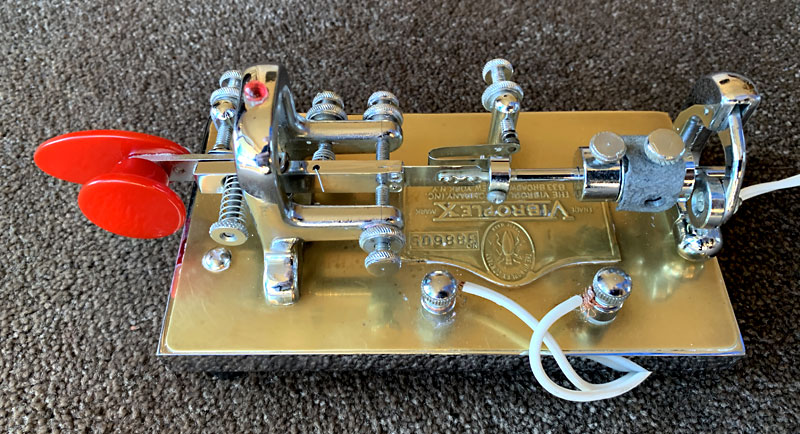
This Vibroplex Presentation bug, s/n 388605, was one of the last to carry the NYC nameplate. Vibroplex moved to Portland, Maine in 1979. Photos: ZL4CU
By Gil ZL4CU
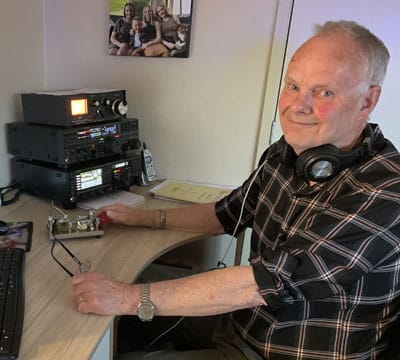 My key is a Vibroplex Presentation with gold-plated base top. Jewel bearings in the main shaft make it very smooth. This one came as a gift from John Tatum, the boss of an oil prospecting company in Foveaux Strait where I worked in communications. I think it was Penrod “75” – not sure about that though.
My key is a Vibroplex Presentation with gold-plated base top. Jewel bearings in the main shaft make it very smooth. This one came as a gift from John Tatum, the boss of an oil prospecting company in Foveaux Strait where I worked in communications. I think it was Penrod “75” – not sure about that though.
The bug has been in retirement for the last 20 years or so while I was off the air, so I’m just getting used to it again. I use it when my shake permits – sometimes it doesn’t go well!
I’ve added a bit of weight to help with speed and try to get about 15 dots for the spacing.
* If you have an interesting key for this feature, please send me a nice clear photo and a few words describing it.
Quick notes
 QRM on the net. In the past fortnight we’ve had someone transmitting a carrier on top of the net a few times, and someone sending random code (possibly warming up their fist?). Probably an accident, as it’s not exactly hard to find a clear frequency on 80 metres!
QRM on the net. In the past fortnight we’ve had someone transmitting a carrier on top of the net a few times, and someone sending random code (possibly warming up their fist?). Probably an accident, as it’s not exactly hard to find a clear frequency on 80 metres!
Thinking about QRM led me to wonder how many CW signals we could accommodate on 80 metres without interference. The New Zealand CW sub-band covers 50 kHz (from 3500-3550 kHz). A CW signal keyed at 25 wpm has a bandwidth of approximately 100 Hz. Therefore, we could fit 500 25 wpm signals in the CW sub-band without overlapping. Modern transmitters are so stable, and have such precise frequency displays, that this actually sounds achievable but, unfortunately, we would also need 100Hz filters in our receivers! 🙂
NZART Annual Conference is next weekend in Wellington. If you’re planning to attend, you might like to take a few NZ Net fliers to give to fellow CW operators.
The ZL Sprint series has come to an end. Congratulations to Gerard ZL2GVA who won the CW QRP section and Graeme ZL2TE who came second in the CW open section.
After 80 years of involvement in amateur radio, Harry Dannals W2HD became a Silent Key on 30 August. Harry was 95. He served as ARRL president from 1972 to 1982, and there’s an interesting story about how he got into ham radio, which you can read in the latest ARRL Letter.
Photo flashback
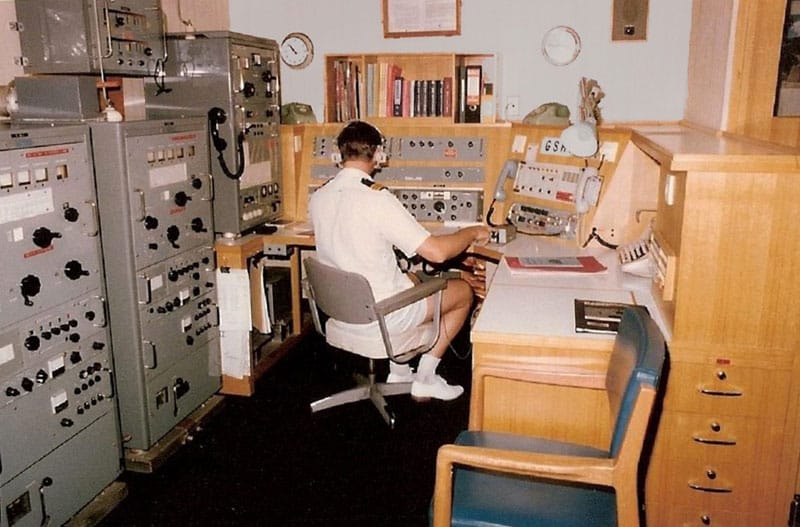
The very tidy radio room of the 69,911 grt bulk carrier Meynell GSHF in December 1978. Meynell was built in 1973 for P&O and broken up in 1998. Photo: jackosan on shipspotting.com
Net ops keep tabs on travelling ‘spy’
By Mike ZL1RA
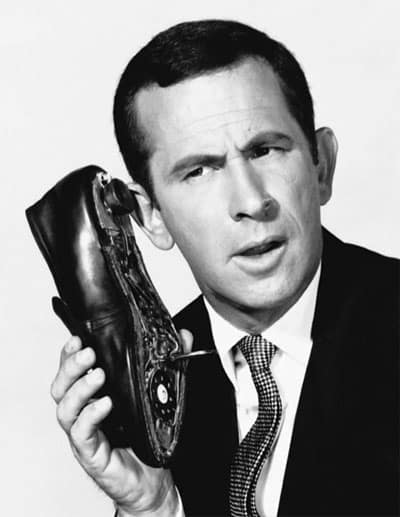 The NZ Net has recently hosted a successful multi traffic handling exercise titled ‘Track the Traveling Spy.’
The NZ Net has recently hosted a successful multi traffic handling exercise titled ‘Track the Traveling Spy.’
The project involved NZ Net operators accepting responsibility for sending the radiogram message of a spy’s location as he proceeded through eight capital cities around the world. Once the spy had completed his journey, the final message was to be relayed back to me, the originating Spymaster.
The full background to the project may be found in the instructions for participants at bit.ly/trackspy.
The spy could easily have disappeared to a sunny, affluent city and never heard from again. All of the NZ Net operators who participated claimed to have found the experience enjoyable although moderately challenging due to the complexity of the radiograms.
The project successfully reached its goal on 31 August 2022. It took 79 days after relaying the first message, from where the spy began his journey to his final destination.
Here are the eight legs of the spy’s journey:
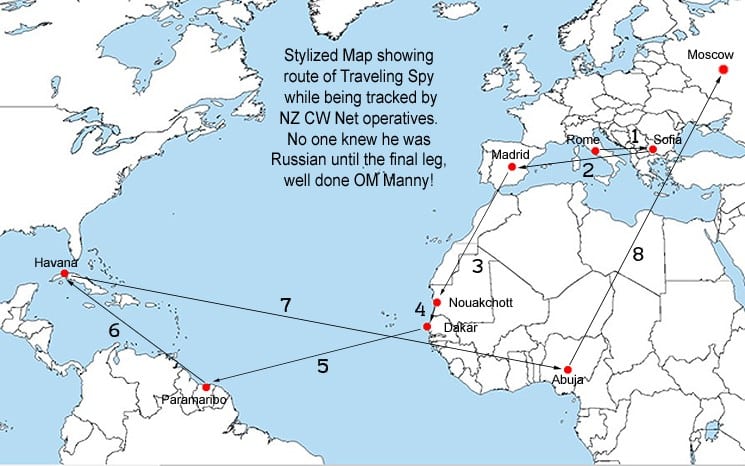
A fine example of a ‘Traveling Spy Radiogram’ comes from the spy’s penultimate leg. It had to be relayed (QSP) because of poor conditions. Peter ZL1PX took over responsibility for the spy in Havana, Cuba, then decided where the spy was about to head to his next appointment, and provided the map coordinates for that city to the spy’s next handler, Manny VK3DRQ. In the event of bad copy which easily corrupts coordinates, the great-circle distance of travel can be used to determine or confirm the destination.
The OPNOTE is outside the check count of the radiogram and is used for clarification of numbers and web links, while also important to prevent duplication of handlers.

A Cold War twist was imaginatively introduced at the last minute, cleverly exploiting the ever-present risk of a spy’s untimely demise when working in the ‘Trade’. It caused the spy’s life to end abruptly in Nigeria at the hands of an unknown assailant.
We can only guess, but the final leg of his journey was likely inside a cheap, 20-gauge carbon steel coffin of the type ubiquitously used in Nigeria for internment and export purposes, but we do know that he was flown out of Nigeria in a Russian Tupolev TU 154 aircraft. The spy being gunned down was a less subtle approach than the methods usually deployed by the KGB to deal with their own.
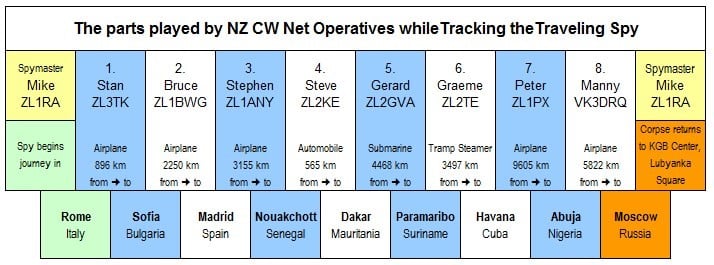
Thanks to the NZ Net operatives who participated in this off-the-wall adventure, and also to those who used their vivid imaginations so effectively to keep it exciting. As the meme goes: ’Who dares Wins’, which indeed each of them did, as they successfully passed along the message and brought the project to an entirely unexpected, but perfectly satisfactory, conclusion.
Letters to the editor: Conversational CW
My editorial, about the dearth of conversational CW these days, which appeared in NZ Net News 87, inspired a few readers to respond:
“I read with interest your comments on conversational contacts (or lack thereof).
“One other thing to consider is the fact ZL can be considered quite rare DX at times. If a ZL calls CW on an open DX band then they are more than likely going to attract a pileup, which is not conducive to long conversations. Personally in these instances I may swap name but not much else and the other station is also conscious there are others waiting so won’t hang around.
“I tend to agree with you that in most cases it is probably a lack of confidence. I’ll readily admit I am not the greatest conversationalist and will rarely go past rig or weather when it comes to topics. I’ll blame the DXer and Contester in me!”
– Mark ZL3AB
“Conversational contacts, has this happened to you…..? Well OM, more than once and some times it made me very disappointed to say the least! The first that comes to mind, was about 30 years ago, when with 25W CW on 20m we could reach the world. I noticed an EA1 calling CQ, he told another op his name and QTH which happened to be only about 22km from where I grew up. My blood temperature rose to the skies and when I called him, I did my introduction in Spanish and said a few words to start. Well, he came back ‘PSE TO MEET U GL 73’.
“I felt like a bucket of icy water came over my overheated blood. Most of the ops from EA, when they find out that I come from there, keep me chatting for a while.”
– Manny VK3DRQ
“I have just had a very interesting CW chat with Tony IK0PHU and thought that you might be interested in his collection of keys/paddles.
“I worked him on 30m with 90W at 0525Z and he was a good signal here with just a little bit of QSB. I got a very detailed WX report which included temp, humidity, wind direction and speed, pressure, sea conditions …. he doesn’t like 5NN TU either ….HI.”
– Grant ZL2GD
Another op who works 100% CW and likes to ragchew is Gan KY8D. He even times his contacts and keeps a running tally of the average duration on each band. Here’s his latest table:

?an says: “Generally, after turning on the rig, I will answer the first CQ heard, whatever the speed. Hearing none, I’ll call CQ myself at 20-ish wpm, on my cootie. Hour-long QSOs are very welcome, while hit-and-run QSOs greatly annoy.”
Cartoon: Gildersleeve
Review: Katakana Man by A Jack Brown

By Graeme ZL2TE
Back in the 1970s I lived just up the road from another ham with whom I became very friendly. He was a very clever man and had a stock of electronic parts and an ability to do things with them way beyond mine. As I became a trusted friend, he revealed to me that he had been a boffin at Bletchley Park during World War 2 but he never told me exactly what his work was, as it was still classified even then.
When I came across the book Katakana Man I felt the same poignancy, as I read of another person who did amazing things which were kept secret. Because of this secrecy there could be no recognition, awards or admiration for their heroic achievements during the war.
Katakana Man is the story of Jack Brown (pictured above in 1991), an Australian who was trained as a Morse operator and, due to his special aptitude, was additionally trained to copy Japanese Kana CW at 40 to 50 wpm. Yes, the Japanese really did send their 73-character alphabet at those speeds and with suffixes to change the inflection of the words, as the same word could have several meanings depending on how it was spoken.
Jack was only 18 when he began training to be a pilot in the RAAF. But when his aptitude for Morse was discovered he was soon reassigned to wireless training.
I don’t want to spoil the tale and will simply say that nothing is hidden now that the service is declassified and the story is well illustrated with plenty of photographs and supporting documents. The book, published in 2006, is very readable and written with an honesty and attention to facts that make you believe that you have experienced the events yourself.
The information that was intercepted by these operators was of critical importance and as you progress through the book you will realise that these operators were putting their life on the line. At first, the information they intercepted was frequently ignored or discarded but, after many lives were needlessly lost, it became critical intelligence. It is hard not to feel angry that these servicemen were ripped off by officialdom and denied their true recognition but by reading this story you will help put some of this right.
Inextricably interwoven into this story is the story of Morse code. How it was learned, how it was used and how it changed the course of the war. For those of us who keep the code alive maybe we have the guiding hand of one of the Katakana men on our own as we send.
You can download a free PDF of Katakana Man here.
Net numbers
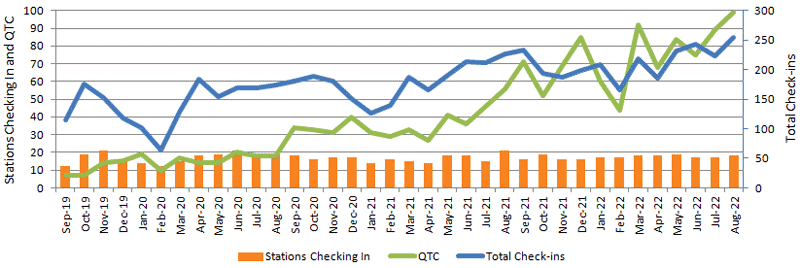
August was a busy and productive month for NZ Net, with three records established:
1. Total check-ins were 255, beating the 243 check-ins in June.
2. Traffic handled totaled 99 radiograms, seven higher than the old record set in March.
3. And, after almost 900 sessions of the NZ Net, we have finally broken our record of 14 check-ins to a single session. Grant ZL2GD was the Net Controller on Tuesday 23 August when 15 stations checked-in.
Here is the monthly net report, sent to all stations on 2 September:
NR39 R ZL1NZ 45/42 AUCKLAND 0900Z 2SEP22 = NZ NET = AUGUST QNI VK3DRQ 19 VK4OP 1 VK4PN 20 ZL1AJY 7 ZL1ANY 20 ZL1BWG 22 ZL1NZ 23 ZL1PC 1 ZL1PX 16 ZL1RA 17 ZL2GD 16 ZL2GVA 17 ZL2KE 10 ZL2LN 12 ZL2TE 18 ZL3TK 23 ZL4CU 8 ZL4KX 5 TOTAL 255 QTC 99 = ZL1NZ
Video: Arduino-based Morse translator
Audio challenge
Your challenge is to tell me which two stations are heard in this recording and what did they agree to do.
(Audio courtesy ZL2TX)
Please send your answer to me via radiogram, or via email if you don’t have propagation.
Answer to previous edition’s Morse Challenge
There were 36,000 poles on the Australian Overland Telegraph Line, as stated in dots and dashes on the 150th anniversary commemorative coin. Too bad no one fixed the incorrect spacing of the Morse characters on the coin before it was produced.
The text reads “36000 POLES 2839 KILOMETRES” with the years 1872 and 2022 at top and bottom.
Correct answers were received from VK3DRQ, ZL1ANY, ZL1PHX, ZL2GVA, ZL3TK and ZL4RO.
Advertising archive

Here’s the perfect gadget for all NZ Net operators. Imagine being able to QNY Up 5 or Down 5, then back to net frequency by simply rotating the desired crystal into position. Sadly, this handy gadget was made way back in 1947 and is probably pretty scarce now, so you’ll just have to use your VFO.
Suggestions?
If you have suggestions on how to make the NZ Net better, or things you’d like to see covered in these updates, please contact ZL1NZ. You might even like to write something for the newsletter.
Thanks for reading, and I hope to hear you soon on the NZ Net!
—
Neil Sanderson ZL1NZ, Net Manager
New Zealand Net (NZ NET)
3535.0 kHz at 9pm NZT Mon-Fri




